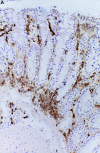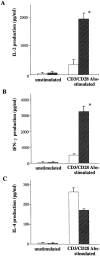Interleukin 7 transgenic mice develop chronic colitis with decreased interleukin 7 protein accumulation in the colonic mucosa
- PMID: 9449719
- PMCID: PMC2212121
- DOI: 10.1084/jem.187.3.389
Interleukin 7 transgenic mice develop chronic colitis with decreased interleukin 7 protein accumulation in the colonic mucosa
Abstract
We have demonstrated that intestinal epithelial cells produce interleukin 7 (IL-7), and IL-7 serves as a potent regulatory factor for proliferation of intestinal mucosal lymphocytes expressing functional IL-7 receptor. To clarify the mechanism by which locally produced IL-7 regulates the mucosal lymphocytes, we investigated IL-7 transgenic mice. Here we report that transgenic mice expressing murine IL-7 cDNA driver by the SRalpha promoter developed chronic colitis in concert with the expression of SRalpha/IL-7 transgene in the colonic mucosa. IL-7 transgenic but not littermate mice developed chronic colitis at 4-12 wk of age, with histopathological similarity to ulcerative colitis in humans. Southern blot hybridization and competitive PCR demonstrated that the expression of IL-7 messenger RNA was increased in the colonic mucosal lymphocytes but not in the colonic epithelial cells. IL-7 protein accumulation was decreased in the goblet cell-depleted colonic epithelium in the transgenic mice. Immunohistochemical and cytokine production analysis showed that lymphoid infiltrates in the lamina propria were dominated by T helper cell type 1 CD4+ T cells. Flow cytometric analysis demonstrated that CD4+ intraepithelial T cells were increased, but T cell receptor gamma/delta T cells and CD8alpha/alpha cells were not increased in the area of chronic inflammation. Increased IL-7 receptor expression in mucosal lymphocytes was demonstrated in the transgenic mice. These findings suggest that chronic inflammation in the colonic mucosa may be mediated by dysregulation of colonic epithelial cell-derived IL-7, and this murine model of chronic colitis may contribute to the understanding of the pathogenesis of human inflammatory bowel disease.
Figures




























Similar articles
-
Interleukin 7 is produced by human intestinal epithelial cells and regulates the proliferation of intestinal mucosal lymphocytes.J Clin Invest. 1995 Jun;95(6):2945-53. doi: 10.1172/JCI118002. J Clin Invest. 1995. PMID: 7769137 Free PMC article.
-
Mucosal IL-7-mediated immune responses in chronic colitis-IL-7 transgenic mouse model.Immunol Res. 1999;20(3):251-9. doi: 10.1007/BF02790408. Immunol Res. 1999. PMID: 10741865 Review.
-
Irsogladine Maleate Prevents Colitis in Interleukin-10 Gene-Deficient Mice by Reducing Interleukin-12 and -23 Production.Biol Pharm Bull. 2015;38(11):1681-8. doi: 10.1248/bpb.b15-00189. Biol Pharm Bull. 2015. PMID: 26521820
-
Regulation of gut inflammation and th17 cell response by interleukin-21.Gastroenterology. 2008 Apr;134(4):1038-48. doi: 10.1053/j.gastro.2008.01.041. Epub 2008 Jan 17. Gastroenterology. 2008. PMID: 18395085
-
Mucosal T cells as a target for treatment of IBD.J Gastroenterol. 2003 Mar;38 Suppl 15:48-50. J Gastroenterol. 2003. PMID: 12698871 Review.
Cited by
-
IL-7 receptor α blockade, an off-switch for autoreactive T cells.Proc Natl Acad Sci U S A. 2012 Jul 31;109(31):12270-1. doi: 10.1073/pnas.1209749109. Epub 2012 Jul 23. Proc Natl Acad Sci U S A. 2012. PMID: 22826232 Free PMC article. No abstract available.
-
Autoimmune arthritis associated with mutated interleukin (IL)-6 receptor gp130 is driven by STAT3/IL-7-dependent homeostatic proliferation of CD4+ T cells.J Exp Med. 2006 Jun 12;203(6):1459-70. doi: 10.1084/jem.20052187. Epub 2006 May 22. J Exp Med. 2006. PMID: 16717113 Free PMC article.
-
The role of gamma/delta T cells in immunity to infection and regulation of inflammation.Immunol Res. 2004;29(1-3):293-302. doi: 10.1385/ir:29:1-3:293. Immunol Res. 2004. PMID: 15181290 Review.
-
Diversity in the oesophageal phenotypic response to gastro-oesophageal reflux: immunological determinants.Gut. 2002 Apr;50(4):451-9. doi: 10.1136/gut.50.4.451. Gut. 2002. PMID: 11889061 Free PMC article.
-
Potential contribution of IL-7 to allergen-induced eosinophilic airway inflammation in asthma.J Immunol. 2009 Feb 1;182(3):1404-10. doi: 10.4049/jimmunol.182.3.1404. J Immunol. 2009. PMID: 19155487 Free PMC article.
References
-
- Namen AE, Lupton S, Hjerrild K, Wignall J, Mochizuki DY, Schmierer AE, Mosley B, March CJ, Urdal DL, Gillis S, et al. Stimulation of B-cell progenitors by cloned murine interleukin-7. Nature. 1988;333:571–573. - PubMed
-
- Welch PA, Namen AE, Goodwin RG, Armitage R, Cooper MD. Human IL-7: a novel T cell growth factor. J Immunol. 1989;143:3562–3567. - PubMed
Publication types
MeSH terms
Substances
LinkOut - more resources
Full Text Sources
Other Literature Sources
Molecular Biology Databases
Research Materials

